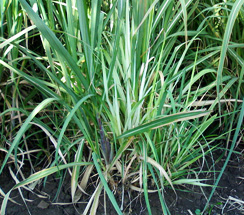Agricultural crops :: Cash crops :: Sugarcane
Grassy shoot disease |
Symptoms:
- Initial symptom appears in the young crop of 3 – 4 months age as thin papery white young leaves at the top of the cane.
- Later, white or yellow tillers appear in large number below these leaves (profuse tillering).
- The cane becomes stunted with reduced internodal length with axillary bud sprouting.
- This disease appears in isolated clumps.
|
 |
 |
 |
 |
| Whitining of leaf |
Profuse tillering |
Reduced internodal length |
Grassy shoot |
|
| Pathogen:
Management strategies
Cultural method:
- Growing resistant varieties viz., Co 86249, CoG 93076 and CoC 22
- Avoid ratooning if Grassy Shoot Disease incidence is more than 15 % in the plant crop
- If disease symptoms are visible within two weeks after planting, such plants can be replaced by healthy plants.
- Uprooted infected plants need to disposed of by burning them.
Physical method:
- Rogue out infected plants in the secondary and commercial seed nursery.
- Treat the setts with aerated steam at 50°C for 1 hour to control primary infection.
- Treating them with hot air at 540C for 8 hours and spraying twice a month with aphidicides.
Chemical method
- Spray dimethoate @ 1ml in 1 litre of water to control insect vector
- Apply pesticide methyl-demeton @ 2ml/lit of water for controlling aphids.
|
|




